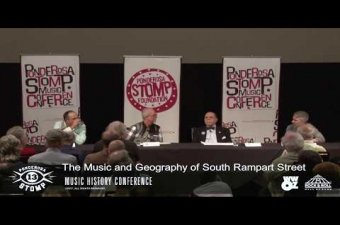The Bop Shop
302 S. Rampart StreetNew Orleans LA 70112
The Bop Shop was a happening record store on a black main street run by a sandy-haired white man from New Jersey named Alvin E. Young. He’d moved to New Orleans in the 1940s and determined that he loved local black music, specifically the rhythm & blues that was just beginning in the Crescent City. He sold R&B records here for years, while for many the neighborhood’s jazz history receded into memory.
Al Young, as he became known, was actually instrumental in the birth of New Orleans R&B. He hung out in black nightclubs and became an amateur talent scout. In 1947 he convinced the Braun brothers of DeLuxe Records in New Jersey to come down and see New Orleans artists. They did, and it was a watershed moment. The Brauns soon recorded a series of artists at Cosimo Matassa’s J&M Studio including Paul Gayten (“True”), Annie Laurie (“Since I Fell for You”), Roy Brown (“Good Rocking Tonight”), Chubby Newsome (“Hip Shakin’ Mama”), Dave Bartholomew (“Country Boy”), and Smiley Lewis (“Here Comes Smiley”).
Young became friends with the local disc jockey Henry “Duke” Thiele, the first popular “Poppa Stoppa” radio personality, who was on the air from 1948 to 1952. This connection impressed Lew Chudd of Imperial Records, whom Young went to work for. Young got the pianist Archibald signed to the label, which released his hit “Stack-A’ Lee” in 1950.
As author Rick Coleman notes in Blue Monday: Fats Domino and the Lost Dawn of Rock ‘n’ Roll, Young also took the fateful trip with Chudd and Dave Bartholomew to the Hideaway in the Lower Ninth Ward to scout Fats Domino. Chudd, who was white, gave Young more authority and money than Bartholomew, who was black, despite Bartholomew’s expertise as an A&R man, producer, arranger, and bandleader. The treatment would eventually compel Bartholomew to leave the label. Young produced some Imperial recordings in 1951, albeit crudely, including Guitar Slim’s first recording and Fats Domino’s first number one hit, “Goin’ Home,” for which he received a co-writing credit.
Young kept the Bop Shop going until the late 1950s, with another location opening on North Rampart near J&M Studio. He then disappeared from the record scene, but he’d made his mark. As the very first New Orleans R&B star, pianist Paul Gayten, said, “Al Young started the whole thing.”
For more on the roots of rock ‘n’ roll in New Orleans click here.
For more on the scene along South Rampart Street click here.
Videos

From the 2017 Ponderosa Stomp Music History Conference, Richard Campanella, Bruce Raeburn, and "Deacon" John Moore discuss music on South Rampart Street with Jordan Hirsch.
Video from Ponderosa Stomp.
From the 2017 Ponderosa Stomp Music History Conference, Richard Campanella, Bruce Raeburn, and "Deacon" John Moore discuss music on South Rampart Street with Jordan Hirsch.
Images















